Analyzing the Origins of the Progressive Education Movement Essay
VerifiedAdded on 2023/06/03
|5
|1148
|287
Essay
AI Summary
This essay delves into the origins of the progressive education movement, tracing its roots in the 19th century as a reaction to traditional teaching methods in the USA and Europe. It highlights the movement's core tenets of embracing diversity, fostering critical thinking, and questioning established educational norms. The essay analyzes the contributions of pivotal figures like John Dewey, who advocated for social reform through education and emphasized the social interactive process of learning; Maria Montessori, who developed a child-centered approach emphasizing a supportive learning environment; and Helen Pankhurst, who pioneered the Dalton Plan, promoting self-directed learning and student collaboration. The essay concludes by emphasizing the lasting impact of these reformers in shaping modern progressive education, promoting student engagement, and democratizing the education system.
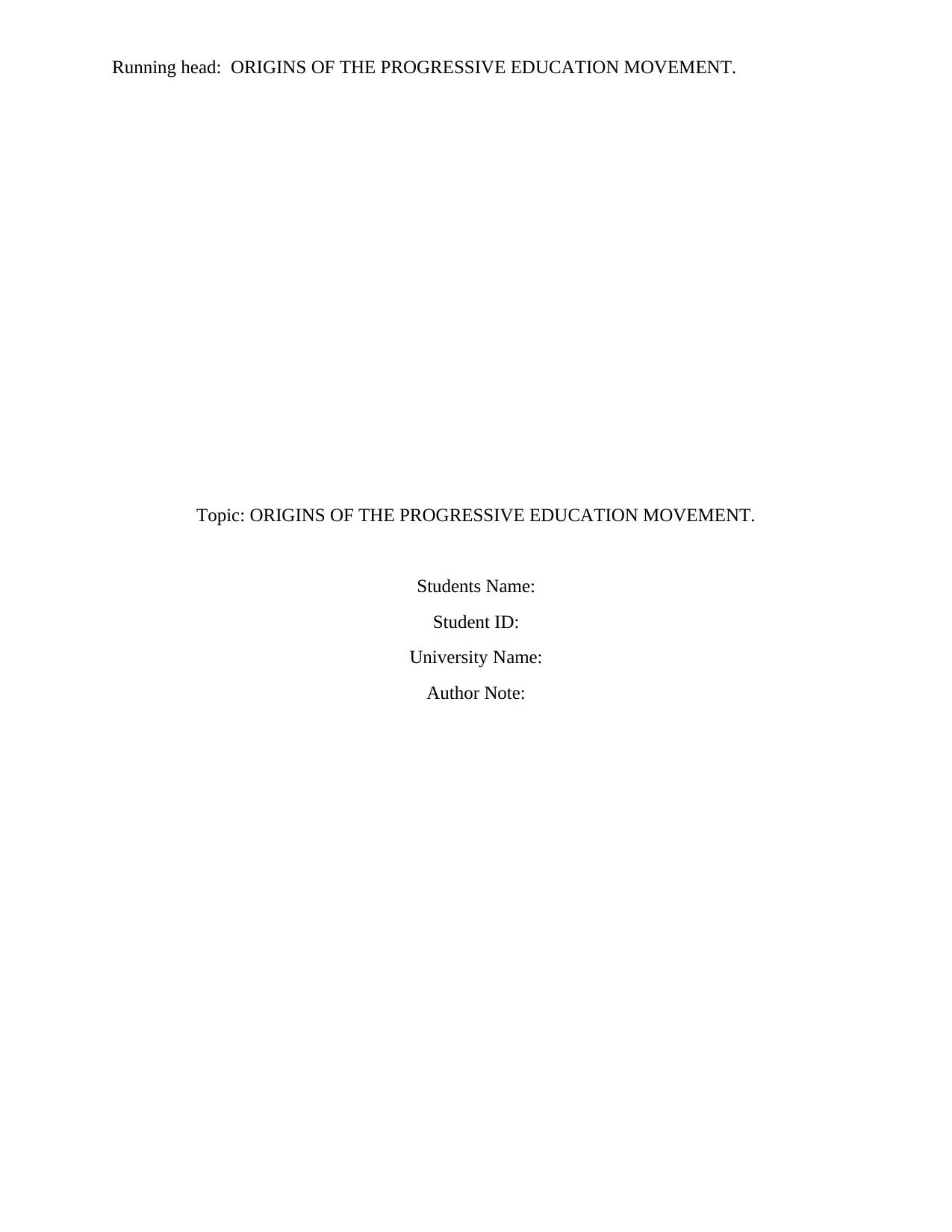
Running head: ORIGINS OF THE PROGRESSIVE EDUCATION MOVEMENT.
Topic: ORIGINS OF THE PROGRESSIVE EDUCATION MOVEMENT.
Students Name:
Student ID:
University Name:
Author Note:
Topic: ORIGINS OF THE PROGRESSIVE EDUCATION MOVEMENT.
Students Name:
Student ID:
University Name:
Author Note:
Paraphrase This Document
Need a fresh take? Get an instant paraphrase of this document with our AI Paraphraser
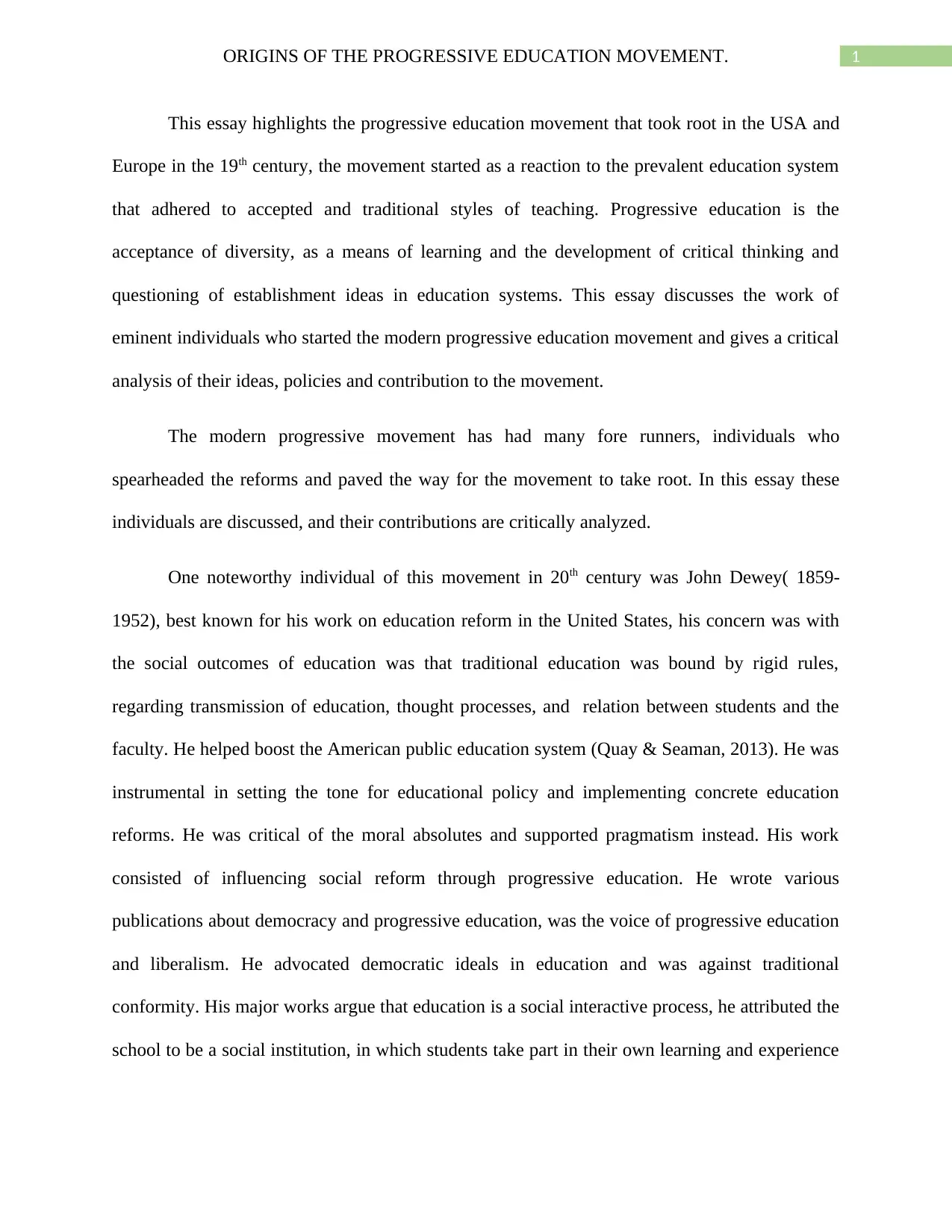
1ORIGINS OF THE PROGRESSIVE EDUCATION MOVEMENT.
This essay highlights the progressive education movement that took root in the USA and
Europe in the 19th century, the movement started as a reaction to the prevalent education system
that adhered to accepted and traditional styles of teaching. Progressive education is the
acceptance of diversity, as a means of learning and the development of critical thinking and
questioning of establishment ideas in education systems. This essay discusses the work of
eminent individuals who started the modern progressive education movement and gives a critical
analysis of their ideas, policies and contribution to the movement.
The modern progressive movement has had many fore runners, individuals who
spearheaded the reforms and paved the way for the movement to take root. In this essay these
individuals are discussed, and their contributions are critically analyzed.
One noteworthy individual of this movement in 20th century was John Dewey( 1859-
1952), best known for his work on education reform in the United States, his concern was with
the social outcomes of education was that traditional education was bound by rigid rules,
regarding transmission of education, thought processes, and relation between students and the
faculty. He helped boost the American public education system (Quay & Seaman, 2013). He was
instrumental in setting the tone for educational policy and implementing concrete education
reforms. He was critical of the moral absolutes and supported pragmatism instead. His work
consisted of influencing social reform through progressive education. He wrote various
publications about democracy and progressive education, was the voice of progressive education
and liberalism. He advocated democratic ideals in education and was against traditional
conformity. His major works argue that education is a social interactive process, he attributed the
school to be a social institution, in which students take part in their own learning and experience
This essay highlights the progressive education movement that took root in the USA and
Europe in the 19th century, the movement started as a reaction to the prevalent education system
that adhered to accepted and traditional styles of teaching. Progressive education is the
acceptance of diversity, as a means of learning and the development of critical thinking and
questioning of establishment ideas in education systems. This essay discusses the work of
eminent individuals who started the modern progressive education movement and gives a critical
analysis of their ideas, policies and contribution to the movement.
The modern progressive movement has had many fore runners, individuals who
spearheaded the reforms and paved the way for the movement to take root. In this essay these
individuals are discussed, and their contributions are critically analyzed.
One noteworthy individual of this movement in 20th century was John Dewey( 1859-
1952), best known for his work on education reform in the United States, his concern was with
the social outcomes of education was that traditional education was bound by rigid rules,
regarding transmission of education, thought processes, and relation between students and the
faculty. He helped boost the American public education system (Quay & Seaman, 2013). He was
instrumental in setting the tone for educational policy and implementing concrete education
reforms. He was critical of the moral absolutes and supported pragmatism instead. His work
consisted of influencing social reform through progressive education. He wrote various
publications about democracy and progressive education, was the voice of progressive education
and liberalism. He advocated democratic ideals in education and was against traditional
conformity. His major works argue that education is a social interactive process, he attributed the
school to be a social institution, in which students take part in their own learning and experience
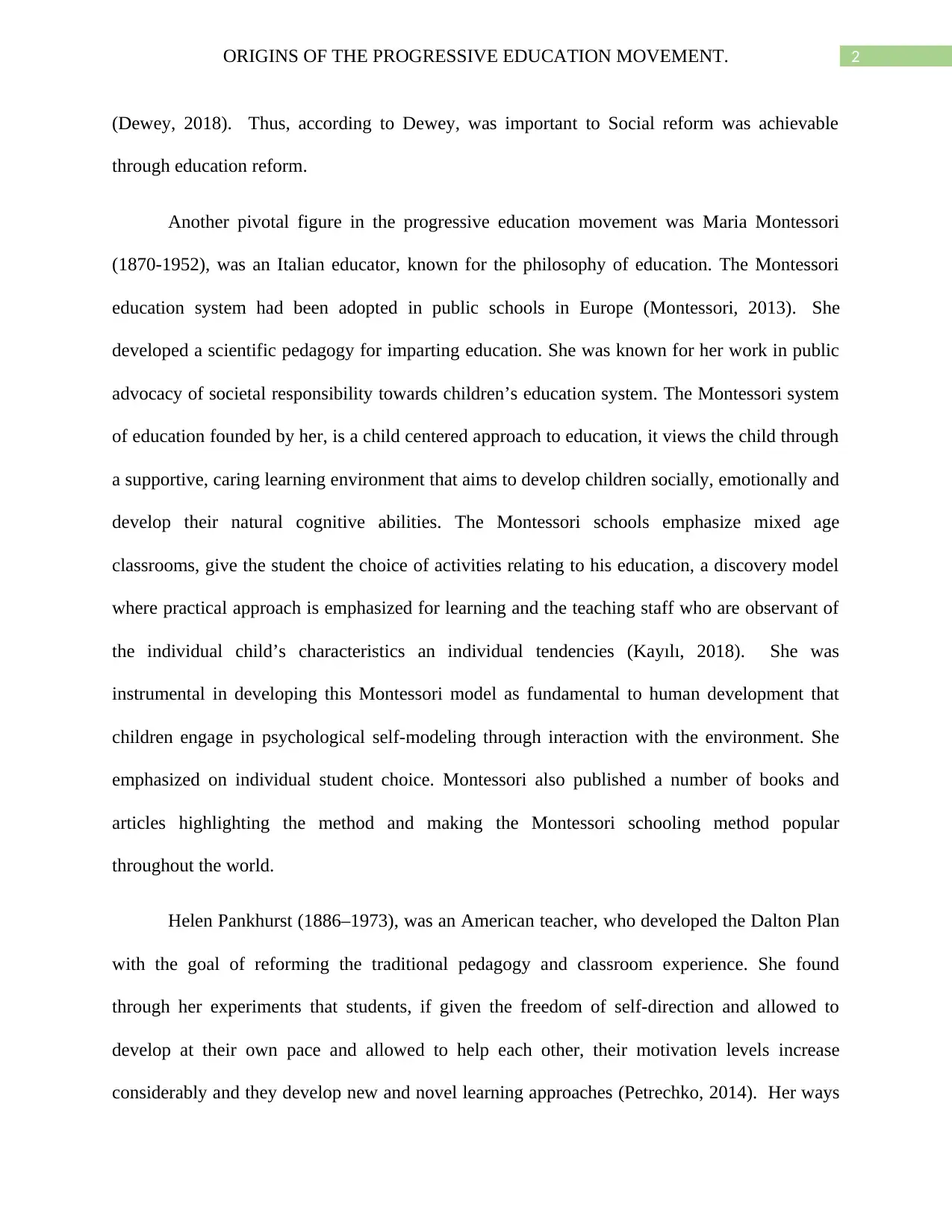
2ORIGINS OF THE PROGRESSIVE EDUCATION MOVEMENT.
(Dewey, 2018). Thus, according to Dewey, was important to Social reform was achievable
through education reform.
Another pivotal figure in the progressive education movement was Maria Montessori
(1870-1952), was an Italian educator, known for the philosophy of education. The Montessori
education system had been adopted in public schools in Europe (Montessori, 2013). She
developed a scientific pedagogy for imparting education. She was known for her work in public
advocacy of societal responsibility towards children’s education system. The Montessori system
of education founded by her, is a child centered approach to education, it views the child through
a supportive, caring learning environment that aims to develop children socially, emotionally and
develop their natural cognitive abilities. The Montessori schools emphasize mixed age
classrooms, give the student the choice of activities relating to his education, a discovery model
where practical approach is emphasized for learning and the teaching staff who are observant of
the individual child’s characteristics an individual tendencies (Kayılı, 2018). She was
instrumental in developing this Montessori model as fundamental to human development that
children engage in psychological self-modeling through interaction with the environment. She
emphasized on individual student choice. Montessori also published a number of books and
articles highlighting the method and making the Montessori schooling method popular
throughout the world.
Helen Pankhurst (1886–1973), was an American teacher, who developed the Dalton Plan
with the goal of reforming the traditional pedagogy and classroom experience. She found
through her experiments that students, if given the freedom of self-direction and allowed to
develop at their own pace and allowed to help each other, their motivation levels increase
considerably and they develop new and novel learning approaches (Petrechko, 2014). Her ways
(Dewey, 2018). Thus, according to Dewey, was important to Social reform was achievable
through education reform.
Another pivotal figure in the progressive education movement was Maria Montessori
(1870-1952), was an Italian educator, known for the philosophy of education. The Montessori
education system had been adopted in public schools in Europe (Montessori, 2013). She
developed a scientific pedagogy for imparting education. She was known for her work in public
advocacy of societal responsibility towards children’s education system. The Montessori system
of education founded by her, is a child centered approach to education, it views the child through
a supportive, caring learning environment that aims to develop children socially, emotionally and
develop their natural cognitive abilities. The Montessori schools emphasize mixed age
classrooms, give the student the choice of activities relating to his education, a discovery model
where practical approach is emphasized for learning and the teaching staff who are observant of
the individual child’s characteristics an individual tendencies (Kayılı, 2018). She was
instrumental in developing this Montessori model as fundamental to human development that
children engage in psychological self-modeling through interaction with the environment. She
emphasized on individual student choice. Montessori also published a number of books and
articles highlighting the method and making the Montessori schooling method popular
throughout the world.
Helen Pankhurst (1886–1973), was an American teacher, who developed the Dalton Plan
with the goal of reforming the traditional pedagogy and classroom experience. She found
through her experiments that students, if given the freedom of self-direction and allowed to
develop at their own pace and allowed to help each other, their motivation levels increase
considerably and they develop new and novel learning approaches (Petrechko, 2014). Her ways
⊘ This is a preview!⊘
Do you want full access?
Subscribe today to unlock all pages.

Trusted by 1+ million students worldwide
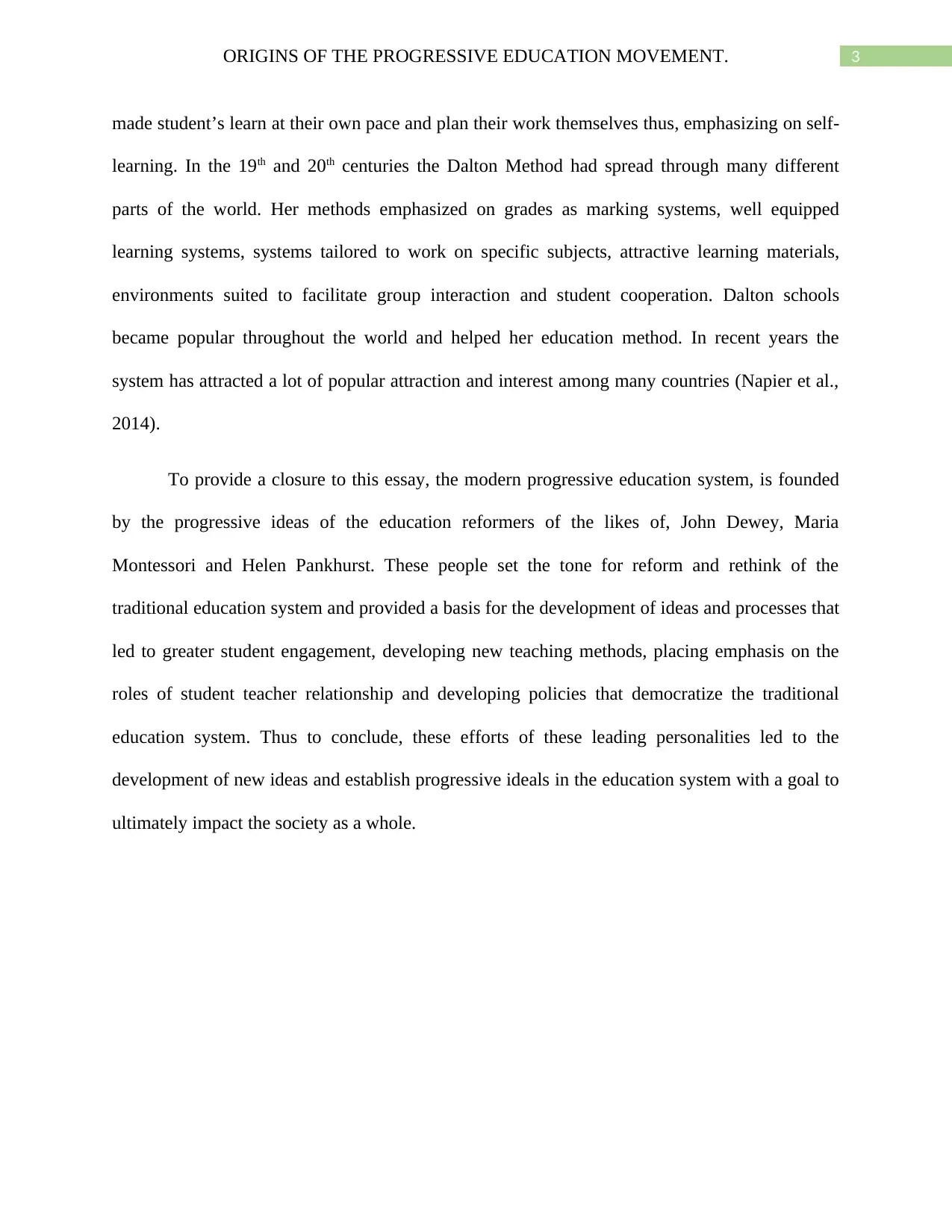
3ORIGINS OF THE PROGRESSIVE EDUCATION MOVEMENT.
made student’s learn at their own pace and plan their work themselves thus, emphasizing on self-
learning. In the 19th and 20th centuries the Dalton Method had spread through many different
parts of the world. Her methods emphasized on grades as marking systems, well equipped
learning systems, systems tailored to work on specific subjects, attractive learning materials,
environments suited to facilitate group interaction and student cooperation. Dalton schools
became popular throughout the world and helped her education method. In recent years the
system has attracted a lot of popular attraction and interest among many countries (Napier et al.,
2014).
To provide a closure to this essay, the modern progressive education system, is founded
by the progressive ideas of the education reformers of the likes of, John Dewey, Maria
Montessori and Helen Pankhurst. These people set the tone for reform and rethink of the
traditional education system and provided a basis for the development of ideas and processes that
led to greater student engagement, developing new teaching methods, placing emphasis on the
roles of student teacher relationship and developing policies that democratize the traditional
education system. Thus to conclude, these efforts of these leading personalities led to the
development of new ideas and establish progressive ideals in the education system with a goal to
ultimately impact the society as a whole.
made student’s learn at their own pace and plan their work themselves thus, emphasizing on self-
learning. In the 19th and 20th centuries the Dalton Method had spread through many different
parts of the world. Her methods emphasized on grades as marking systems, well equipped
learning systems, systems tailored to work on specific subjects, attractive learning materials,
environments suited to facilitate group interaction and student cooperation. Dalton schools
became popular throughout the world and helped her education method. In recent years the
system has attracted a lot of popular attraction and interest among many countries (Napier et al.,
2014).
To provide a closure to this essay, the modern progressive education system, is founded
by the progressive ideas of the education reformers of the likes of, John Dewey, Maria
Montessori and Helen Pankhurst. These people set the tone for reform and rethink of the
traditional education system and provided a basis for the development of ideas and processes that
led to greater student engagement, developing new teaching methods, placing emphasis on the
roles of student teacher relationship and developing policies that democratize the traditional
education system. Thus to conclude, these efforts of these leading personalities led to the
development of new ideas and establish progressive ideals in the education system with a goal to
ultimately impact the society as a whole.
Paraphrase This Document
Need a fresh take? Get an instant paraphrase of this document with our AI Paraphraser
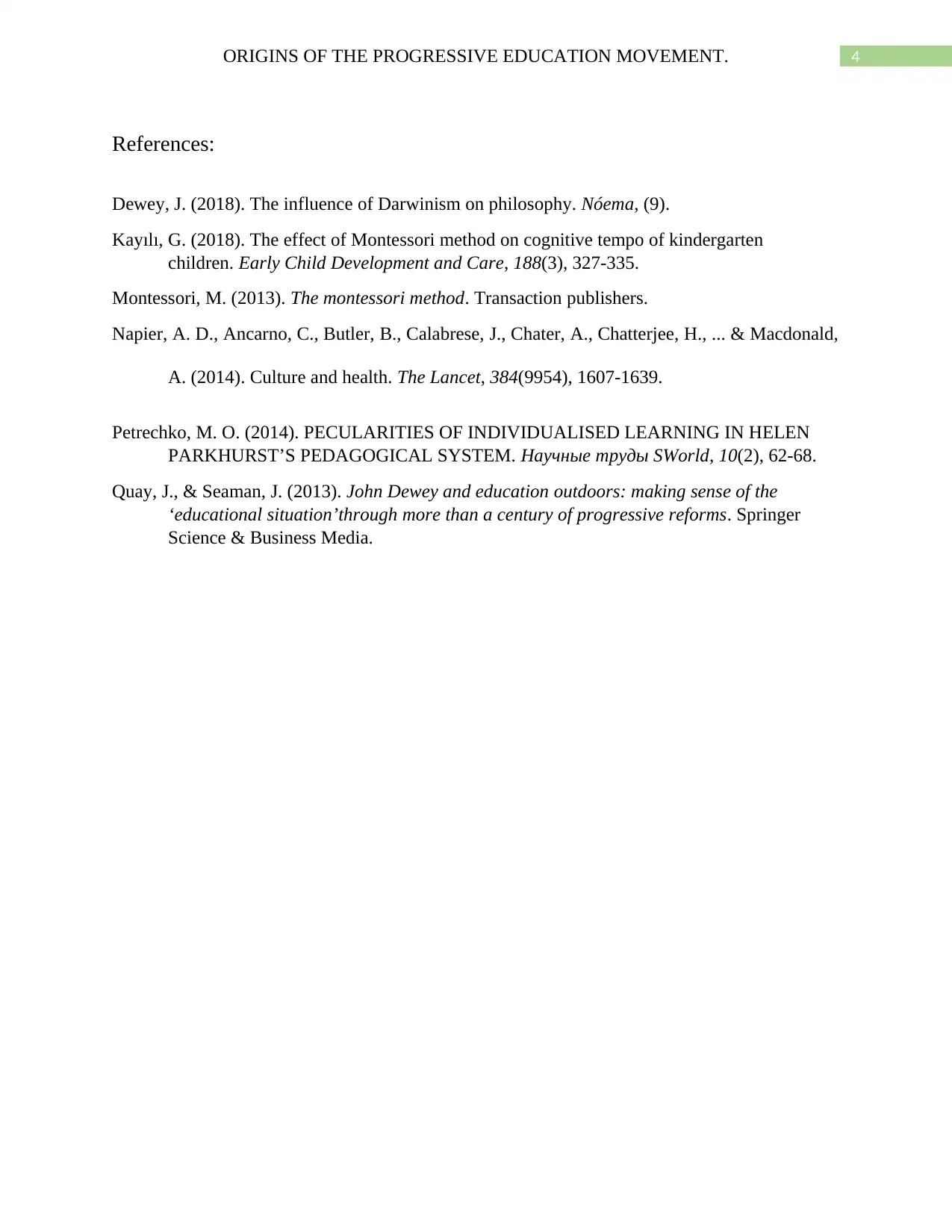
4ORIGINS OF THE PROGRESSIVE EDUCATION MOVEMENT.
References:
Dewey, J. (2018). The influence of Darwinism on philosophy. Nóema, (9).
Kayılı, G. (2018). The effect of Montessori method on cognitive tempo of kindergarten
children. Early Child Development and Care, 188(3), 327-335.
Montessori, M. (2013). The montessori method. Transaction publishers.
Napier, A. D., Ancarno, C., Butler, B., Calabrese, J., Chater, A., Chatterjee, H., ... & Macdonald,
A. (2014). Culture and health. The Lancet, 384(9954), 1607-1639.
Petrechko, M. O. (2014). PECULARITIES OF INDIVIDUALISED LEARNING IN HELEN
PARKHURST’S PEDAGOGICAL SYSTEM. Научные труды SWorld, 10(2), 62-68.
Quay, J., & Seaman, J. (2013). John Dewey and education outdoors: making sense of the
‘educational situation’through more than a century of progressive reforms. Springer
Science & Business Media.
References:
Dewey, J. (2018). The influence of Darwinism on philosophy. Nóema, (9).
Kayılı, G. (2018). The effect of Montessori method on cognitive tempo of kindergarten
children. Early Child Development and Care, 188(3), 327-335.
Montessori, M. (2013). The montessori method. Transaction publishers.
Napier, A. D., Ancarno, C., Butler, B., Calabrese, J., Chater, A., Chatterjee, H., ... & Macdonald,
A. (2014). Culture and health. The Lancet, 384(9954), 1607-1639.
Petrechko, M. O. (2014). PECULARITIES OF INDIVIDUALISED LEARNING IN HELEN
PARKHURST’S PEDAGOGICAL SYSTEM. Научные труды SWorld, 10(2), 62-68.
Quay, J., & Seaman, J. (2013). John Dewey and education outdoors: making sense of the
‘educational situation’through more than a century of progressive reforms. Springer
Science & Business Media.
1 out of 5
Related Documents
Your All-in-One AI-Powered Toolkit for Academic Success.
+13062052269
info@desklib.com
Available 24*7 on WhatsApp / Email
![[object Object]](/_next/static/media/star-bottom.7253800d.svg)
Unlock your academic potential
Copyright © 2020–2025 A2Z Services. All Rights Reserved. Developed and managed by ZUCOL.





